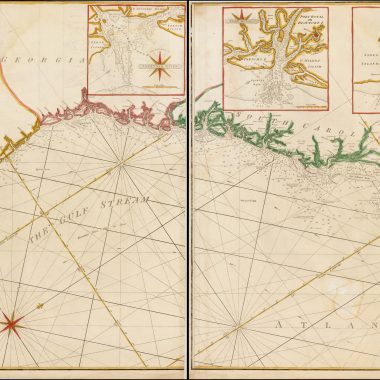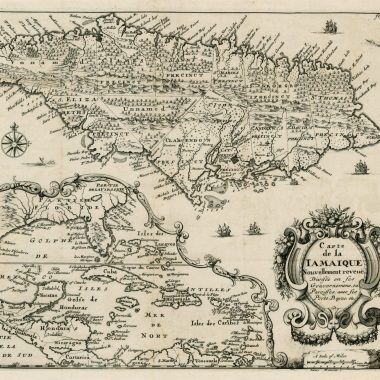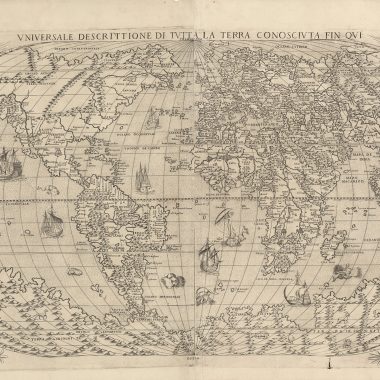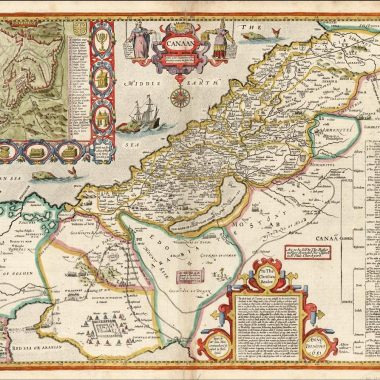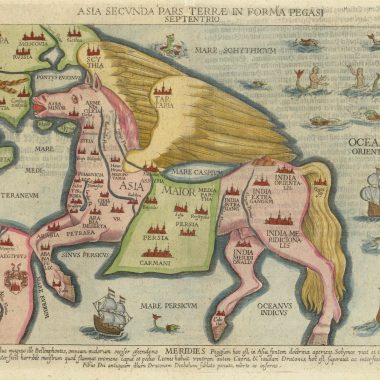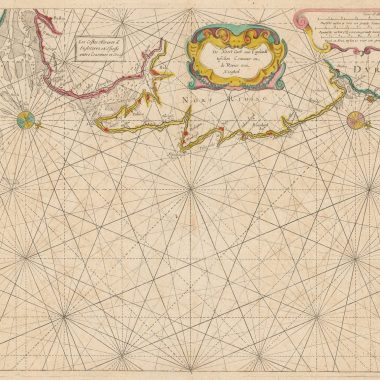
[ANONYMOUS / Henri Abraham CHATELAIN ?]
AFBEELDINGHE van’t zeer vermaerde Eiland GEKS-KOP. geligen in de Actie-ze, ontdekt door Mons.r Lau-rens, werende bewoond door een verzameling van alderhande Volkeren. die men dezen generalen Naam (Actionisten) geest. [L’Honore & Chatelain, Amsterdam, 1720]
From: [Anonymous] ‘Het Groote Tafereel der Dwassheid …’ (The Great Mirror of Folly)
Copperplate engraving, image 160 x 225mm.
One of the most famous cartographic curiosities, this engraving is a satire on the collapse of the French Compagnie d’Occident, and similar English and Dutch companies.
The Compagnie de la Louisiane ou d’Occident was established in August 1717 by John Law, a Scottish financial genius. The Compagnie was granted control of Louisiana. The Company’s plans to exploit the resources of the region – the ‘Mississippi Scheme’ – captured the popular imagination. Believing that the region was a source of limitless wealth, people rushed to invest. Share prices opened at 500 livres, but rapidly rose to 18,000 livres. At this point, speculators indulged in profit-taking, causing a run on the shares. Confidence collapsed, causing a run on the company’s capital and the company went bankrupt. Many individuals were ruined, not only in France, but throughout Europe.
As a consequence of the failure of the Mississippi Scheme, confidence in other similar schemes failed, including the English South Sea Company collapsed, as did a number of smaller Dutch companies. The general term ‘Bubbles’ was applied to such schemes where promises proved illusory, burst by the pin of reality.
The background to the affair is described more fully elsewhere in this issue.
This fine engraving is comprised of punning references to these ‘Bubbles’, in particular emphasising the consequences for the hapless investors, who bore the brunt of the failure, and yet emphasising their greed and foolishness in believing the wild promises made on behalf of the various companies.
The title translates “Representation of the very famous island of Mad-head, lying in the sea of shares, discovered by Mr. Law-rens, and inhabited by a collection of all kinds of people, to whom are given the general name shareholders.”
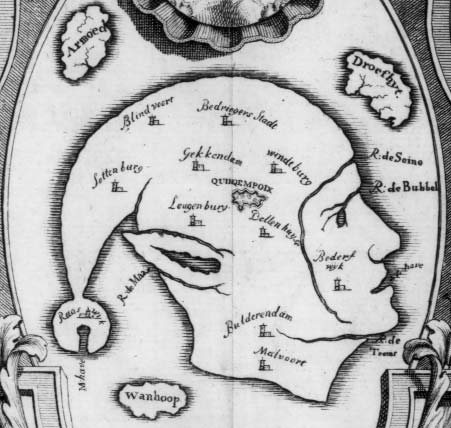
a man’s head, wearing a fool’s cap, with bell, but with the ears of a jackass
Principal names within the map:
QUINQUEPOIX: capital of the island, named after the headquarters of the Compagnie in the Rue Quimquempoix, Paris.
R: de Seine, R. de Teems & R. de Maas: the principal rivers of the three major countries involved: the Seine (Paris), the Thames (London) and Meuse
(Amsterdam).
R: de Bubbel: Bubble River
Z.Z. have: South Sea Haven, alluding to the English South Sea scheme.
M. have: ie Mississippi haven.
(Thanks to John Goss for help with translations.)
Blind voort: Fort Blind
Bedriegers Stadt: Deceivers’ Town
Sottenburg: Foolsburg
Gekkendam: Fool’s Dyke
Windtburg: Windburg
Leugenburg: Liarsburg
Dollen huyse: Madhouse
Bederf wyk: Abandoned Quarter
Raas wyk: Noise Quarter
Bulderendam: Roaring Dyke
Malvoort: Fort Evil
Armoed: Island of Poverty
Droefhyt: Island of Sorrow
Wanhoop: Island of Despair
Outside the map itself are two larger and two smaller scenes.
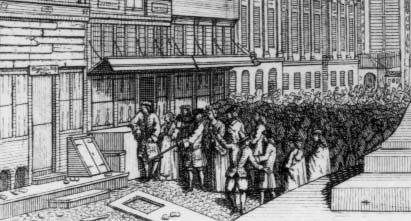
Bottom left: ‘Quinquempoix Beplystert’ (Quinquempoix Besieged). This shows the headquarters of the French Company, in Rue Quimquempoix besieged by unhappy investors.
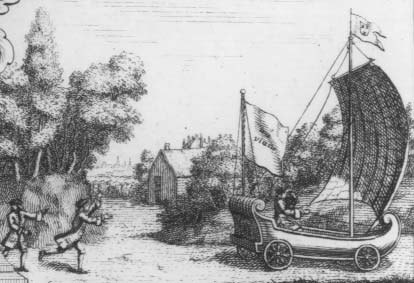
Bottom right: ‘Vlugt De Inwoonde von’t Eilant Geks Kop’ (Flight of the Inhabitants of madhead Island). A distraught investor is seen fleeing from his angry creditors in a land-yacht, an allusion to some of the bizarre inventions being proposed at the time. The land-yacht is taking him na viane – to Vianen – home to an infamous lunatic asylum.
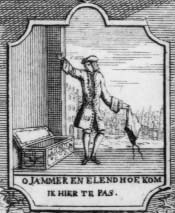
Top left: An investor, with his money-chest and money-bags empty is saying: “0 Jammer en Elend Hoe Kom Ik Hier Te Pas” (Oh Pity and Misery! How have I come to this).
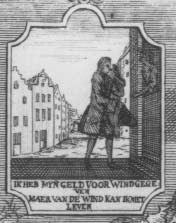
Top Right: An investor talks to a lady, saying: “Ik Heb Myn Geld voor Windgege ven Maer van de Wind kan Komet Leven” (I have given my money for wind [empty promises], but I cannot live from wind)
In the frame around the map is shown an owl, with the motto ‘Ik Bemin De Duysternis’ (I like darkness). and a cat, with the motto ‘By Nacht soek Ik myn Fortuyn’ (I seek my fortune by night). Above the map is shown ‘T Waapen Van Dit Eyland’ (The Arms of this Island) – a share certificate, dated 1720, which is shown being blown about by the 5 winds, symbolising the worthlessness of the certificate in the winds of fortune.
British Museum, Catalogue of Prints and Drawings In The British Museum. Division I Political And Personal Satires, vol.II (London, British Museum. 1873), p.541-543


